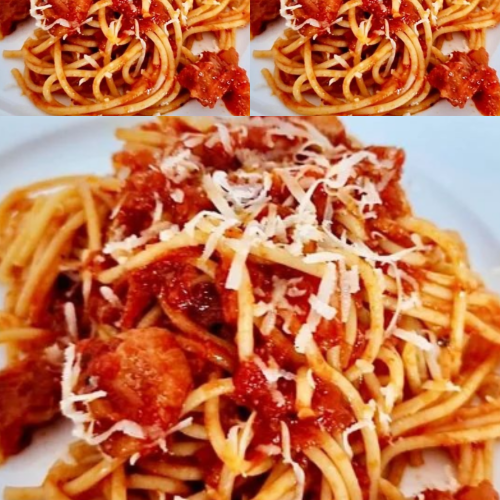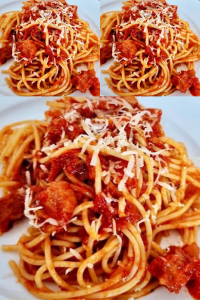Step-by-Step Instructions
Step 1: Prepare the Pasta
Bring a large pot of salted water to a rolling boil.
Add the bucatini pasta and cook according to the package instructions, until al dente. Reserve about 1 cup of pasta water before draining.
Step 2: Cook the Guanciale
Heat a large skillet over medium heat. Add the guanciale and cook for 5-7 minutes, stirring occasionally, until it turns golden and crispy.
If the guanciale releases too much fat, you can remove a bit, but leave enough for flavor.
Step 3: Build the Sauce
(Optional) Add the finely chopped onion to the skillet and sauté until translucent, about 3 minutes.
Stir in the crushed tomatoes and chili (if using). Let the sauce simmer gently for 10-12 minutes, stirring occasionally, until it thickens slightly.
Season with a pinch of salt and freshly ground black pepper.
Step 4: Combine Pasta and Sauce
Add the drained bucatini to the skillet with the sauce. Toss well to coat the pasta evenly.
Gradually add a splash of reserved pasta water if the sauce seems too thick.
Step 5: Final Touches
Remove the skillet from the heat. Sprinkle half of the grated Pecorino Romano and toss again.
Serve immediately, garnished with the remaining Pecorino Romano and a twist of freshly ground black pepper.
Tips & Variations
Vegetarian Substitution: Swap guanciale with smoked tofu or sautéed mushrooms for a vegetarian twist.
Gluten-Free Option: Use gluten-free bucatini or spaghetti.
Spicy Variation: Increase the chili for a spicier kick, or omit it entirely for a milder dish.
Onion Debate: Traditional Amatriciana recipes do not include onion. However, adding it can introduce a subtle sweetness to the sauce—experiment to find your preference.
Cheese Swap: While Pecorino Romano is traditional, Parmesan can be used in a pinch.

